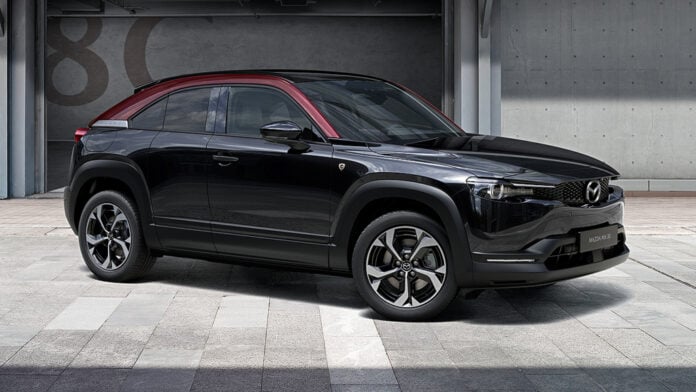The automotive landscape is experiencing a notable shift, as electric vehicles (EVs) gain traction among consumers. The Mazda MX-30, a compact SUV, is emerging as a popular choice on the streets, reflecting a growing trend towards sustainable transportation. With increasing environmental awareness and government incentives for electric vehicles, the market is ripe for innovative models that blend style, practicality, and eco-friendliness. The MX-30 stands out with its unique design and features tailored to modern drivers, but how does it compare to other vehicles in its class?
As the demand for electric vehicles rises, the competition intensifies. The Mazda MX-30 is not just another entry into the EV market; it represents a strategic shift for the brand, aiming to capture the attention of environmentally conscious consumers. Priced competitively with discounts reaching up to $11,500, it presents an attractive option for those looking to transition to electric driving. However, the question remains: does the MX-30 offer enough value and performance to sway potential buyers away from more established competitors?
Design and Features That Captivate
The Mazda MX-30 boasts a striking design that sets it apart from traditional SUVs. With its sleek lines and distinctive freestyle doors, the MX-30 offers a modern aesthetic that appeals to a younger demographic. Inside, the cabin reflects Mazda’s commitment to quality, featuring sustainable materials such as recycled plastics and natural fibers. This focus on eco-friendliness not only enhances the vehicle’s appeal but also aligns with the growing consumer demand for environmentally responsible products.
Equipped with a 7.0-inch infotainment system, the MX-30 provides seamless connectivity options, including Apple CarPlay and Android Auto. The layout is driver-centric, ensuring that essential controls are easily accessible. Safety features such as adaptive cruise control and lane-keeping assist further enhance the driving experience, making it a well-rounded choice for urban environments. The combination of practicality and style positions the MX-30 as a compelling option for those seeking a versatile electric SUV.
However, while the design and features are impressive, potential buyers should consider the vehicle’s performance. The MX-30 is powered by a 35.5 kWh battery, offering an estimated range of about 100 miles on a single charge. This range may be sufficient for daily commuting but could pose challenges for longer trips. As consumers increasingly prioritize range and charging infrastructure, the MX-30 must compete against rivals that offer more extensive capabilities. Understanding these dynamics will be crucial for Mazda as it seeks to establish its presence in the competitive EV market.
Performance and Driving Experience
The performance of the Mazda MX-30 is a key factor that influences consumer decisions. With an electric motor delivering 143 horsepower, the MX-30 provides a smooth and responsive driving experience, particularly in urban settings. The vehicle’s low center of gravity enhances stability, allowing for agile handling around corners. This makes it an enjoyable option for drivers who appreciate a spirited driving experience, even in an electric format.
Despite its commendable handling, the MX-30’s acceleration may not match that of some competitors in the electric SUV segment. Models such as the Tesla Model Y and Ford Mustang Mach-E offer quicker acceleration and longer ranges, which could sway performance-oriented buyers. However, the MX-30 compensates with its engaging driving dynamics and well-tuned suspension, providing a balance that many drivers will find appealing.
Moreover, the MX-30’s regenerative braking system contributes to its efficiency, allowing drivers to recapture energy during deceleration. This feature not only enhances the vehicle’s range but also provides a more connected driving experience. As the electric vehicle market evolves, the MX-30’s performance will need to resonate with consumers who seek both excitement and practicality in their daily drive.
Market Position and Competitive Landscape
As the Mazda MX-30 enters a crowded electric vehicle market, understanding its position relative to competitors is crucial. With a starting price of approximately $34,000, it aims to attract buyers looking for an affordable yet stylish electric SUV. The vehicle’s pricing strategy, coupled with significant discounts, positions it as a viable option for budget-conscious consumers transitioning to electric mobility.
In the competitive landscape, the MX-30 faces challenges from established players like the Nissan Leaf and the Hyundai Kona Electric. Both models offer competitive pricing and longer ranges, which could appeal to consumers prioritizing functionality over design. However, the MX-30’s unique styling and commitment to sustainability may attract buyers who value aesthetics and eco-friendly practices.
Furthermore, the growing infrastructure for electric vehicles, including charging stations, plays a pivotal role in shaping consumer preferences. As more charging options become available, the MX-30’s shorter range may become less of a deterrent. Mazda’s marketing strategies and partnerships with charging networks will be essential in effectively positioning the MX-30 against a backdrop of evolving consumer needs and preferences.
The Future of the Mazda Mx-30
The future of the Mazda MX-30 hinges on its ability to adapt to the rapidly changing electric vehicle landscape. As technology advances and consumer expectations evolve, Mazda must continue to innovate and enhance the MX-30’s features and performance. This includes potential updates to the battery technology, aiming to extend its range and improve charging times, which are critical factors for many potential buyers.
Moreover, the increasing focus on sustainability presents an opportunity for Mazda to further emphasize its commitment to eco-friendly practices. By highlighting the use of recycled materials and sustainable production methods, the brand can strengthen its appeal among environmentally conscious consumers. Collaborations with renewable energy providers could also enhance the vehicle’s value proposition, creating a holistic approach to sustainable driving.
In summary, the Mazda MX-30 represents a significant step for the brand into the electric vehicle market. With its unique design, engaging driving experience, and competitive pricing, it has the potential to carve out a niche among electric SUVs. However, the challenges posed by competitors and the need for continuous innovation will determine its long-term success in a dynamic automotive landscape.


